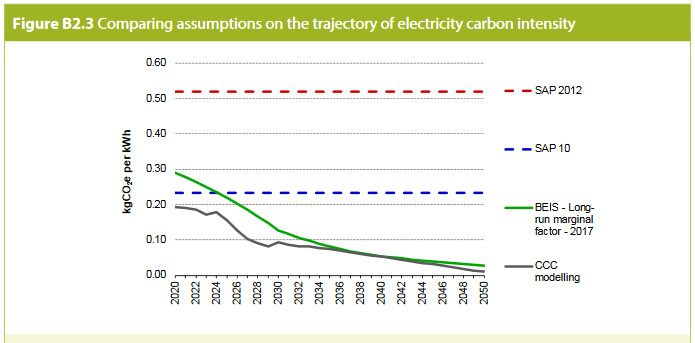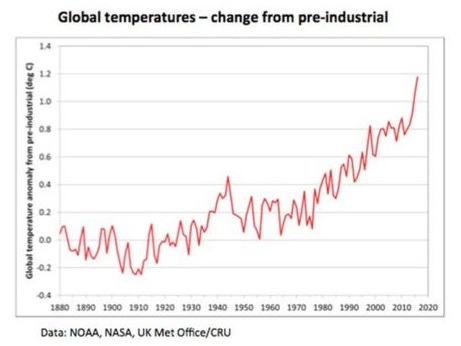UK Housing: fit for the future?
The latest Climate Change Committee report concludes that "UK homes are not fit for the future".
You may not have time to read the full report published in February 2019, "UK Housing: fit for the future?", which runs to 134 pages. This page summarises the main findings which focus, largely, on the urgent need to install heat pumps to reduce carbon emissions.

The CCC reports that greenhouse gas emission reductions from UK housing have stalled, and efforts to adapt the housing stock for higher temperatures are falling far behind schedule and that this increases the risks from the changing climate.
The CCC adds that, "The evidence now indicates that low-carbon heat, and heat pumps specifically, are expected to deliver cost-effective carbon savings in all new build homes by 2025 or earlier".
The CCC says that, "The 29 million existing homes across the UK must be made low-carbon, low-energy and resilient to a changing climate. This is a UK infrastructure priority and should be supported by HM Treasury. Homes should use low-carbon sources of heating such as heat pumps and heat networks. The uptake of energy efficiency measures such as loft and wall insulation must be increased".
No new homes should be connected to the gas grid
The CCC says that, "From 2025 at the latest, no new homes should be connected to the gas grid. They should instead be heated through low carbon sources".
Low-regret actions for buildings decarbonisation
The CCC lists its "Low-regret actions for buildings decarbonisation":
- Heat pumps in buildings not on the gas grid. Heat pumps are the leading low-carbon option for buildings not connected to the gas grid. Together with new build properties, installation of heat pumps in buildings off the gas grid can help create the scale needed for supply chains to develop, potentially in advance of accelerated heat pump roll-out in on-gas grid properties after 2030.
- Low-carbon new build. Installing low-carbon heating from the outset in new homes means that costs of connecting to the gas grid can be avoided and the system designed optimally for the property. This makes heat pumps cheaper to install and run in new homes than in existing gas-heated homes.
- Low-carbon heat networks. District heating schemes require a certain density of heat demand in order to be economic, which means that they are suited to urban areas, new build developments and some rural areas. Low-carbon heat sources can include waste heat, large-scale water-source heat pumps, geothermal heat and potentially hydrogen.
The CCC also discusses the burning issue of the outdated grid carbon factors used by SAP and the "profound influence" this has on delaying the uptake of low carbon technologies, under the following heading:

The influence of SAP on the uptake of low-carbon technologies
Standard Assessment Procedure (SAP) is the basis for establishing compliance with Building Regulations, and for Energy Performance Certificates. SAP makes assessments based on a range of assumptions like the efficiency of heating systems and the emissions intensity of fuels. These assumptions can have a profound influence on the extent to which low-carbon measures are deployed in homes. There are a number of areas where SAP currently fails to value the benefits of low-carbon technologies properly.
The first relates to emission factors for electricity. SAP calculates the energy and carbon implications for building components by using a single emissions factor for each fuel. These emission factors reflect the average carbon intensity published in SAP 2012, when the electricity carbon intensity was set at 0.519 kgCO2 per kWh and this carbon intensity still remains the basis of SAP calculations today. In reality, the carbon intensity of electricity has more than halved since 2012, and it is projected to fall again by over 50% before 2030. In order to value the benefits of low-carbon technologies properly, it is critical that SAP reflects Government expectations on declining grid carbon intensity over the lifetime of the measures being installed.
Secondly, SAP can materially influence the uptake of low-carbon technologies through the technologies it includes and the assumptions it makes around the efficiency of low-carbon heating systems. Committee assessments for air source heat pumps indicate space heating efficiencies significantly higher than those assumed under the SAP default values. In our fifth carbon budget scenarios, we assume a current SPF of 2.5 for air source heat pumps in retrofit, with potential to increase to 3.0 with learning. For new build, we assume an SPF of 2.75. Recent evidence suggests CCC assumptions may remain pessimistic for new homes.
Cliff edge on 31 March 2021?
The CCC is concerned that, "The chopping and changing of Government policy has inhibited skills development in housing design, construction and in the installation of new measures. Key steps for the UK in reducing emissions, like the wider deployment of heat pumps, require new skills".
The RHI is due to end on 31 March 2021 with still no indication of what plans the Government has to support low carbon technologies and the supply chains beyond that date.
A private investment for a public benefit
Investment in low carbon technologies, like heat pumps, is a private investment for a public benefit. Until the Treasury accepts this and acknowledges that public money is needed to encourage the public benefit of lower carbon emissions very few heat pumps will be installed, the skills shortage will remain, the supply chain will be underdeveloped and the current CCC report will need to be recycled every year.
See the full report published in February 2019: "UK Housing: fit for the future?", which runs to 277 pages.
See Ground Source Heating See Ground Source Cooling See Ground Source Energy

